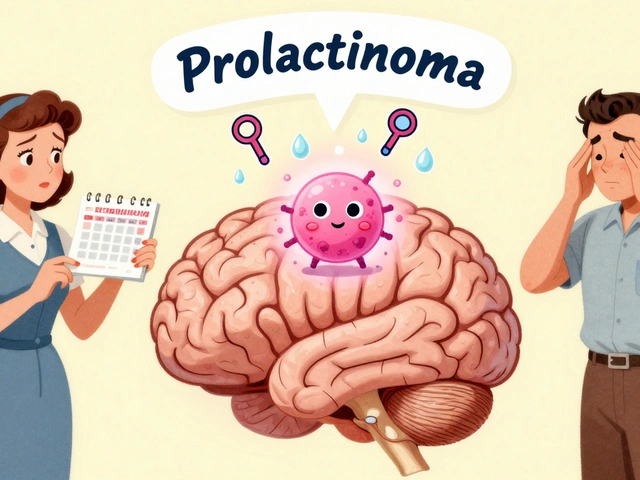Introduction to Acetaminophen
As a blogger and someone who has experienced pain, I know how important it is to find effective relief. Acetaminophen is a common over-the-counter medication that many people rely on to alleviate their pain. In this article, I will discuss the benefits, risks, and proper usage of acetaminophen so you can make informed decisions about your own pain management. Let's start by understanding what acetaminophen is and how it works.
How Acetaminophen Works to Relieve Pain
Acetaminophen, also known as paracetamol, is a pain reliever and fever reducer. It is available over-the-counter, without a prescription, and is a common ingredient in many medications, including cold and flu remedies. Acetaminophen works by blocking the production of prostaglandins, which are chemicals in the body that cause pain and inflammation. By reducing the levels of these chemicals, acetaminophen helps to alleviate pain and fever.
Benefits of Using Acetaminophen
There are several benefits to using acetaminophen for pain relief. First, it is generally safe and well-tolerated by most people, including children and pregnant women. It is also non-habit forming, which means that you can use it without the risk of developing a dependence on it. Additionally, unlike some other pain relievers, acetaminophen does not cause stomach irritation or bleeding, making it a suitable option for those with sensitive stomachs. Finally, because it is available over-the-counter, it is easily accessible and affordable for most people.
Risks Associated with Acetaminophen Use
While acetaminophen is generally safe, there are some risks associated with its use. One of the most significant risks is liver damage, which can occur if you take too much acetaminophen or take it for an extended period. This is because the liver is responsible for breaking down and eliminating the drug from the body. Other risks include allergic reactions, kidney damage, and interactions with other medications. It is essential to follow the recommended dosages and consult with a healthcare professional if you have any concerns about potential risks.
Proper Dosage and Usage Guidelines
To ensure the safe and effective use of acetaminophen, it is crucial to follow the proper dosage and usage guidelines. The recommended dosage for adults is typically 325-650 mg every 4-6 hours, not exceeding 3,000-4,000 mg per day. For children, the dosage will depend on their weight and age. Always follow the instructions on the packaging or consult with a healthcare professional if you are unsure about the appropriate dosage for you or your child.
When to Use Acetaminophen for Pain Relief
Acetaminophen is an appropriate choice for pain relief in various situations, including headaches, menstrual cramps, toothaches, and minor aches and pains associated with the common cold or flu. It can also be used to reduce fever. However, if your pain is severe or persists for more than a few days, it is essential to consult with a healthcare professional for further evaluation and recommendations.
When to Avoid Acetaminophen
While acetaminophen is safe for most people, there are some instances when it should be avoided. If you have a history of liver disease or are currently taking medications that can affect your liver, such as some anticonvulsants, it is essential to speak with a healthcare professional before using acetaminophen. Additionally, if you are allergic to acetaminophen or any of its ingredients, you should avoid using it.
Alternatives to Acetaminophen for Pain Relief
If acetaminophen is not suitable for you, or if you are looking for alternative pain relief options, there are several other medications and remedies available. Nonsteroidal anti-inflammatory drugs (NSAIDs), such as ibuprofen and naproxen, can be effective for pain relief and inflammation reduction. However, they may cause stomach irritation and should be used with caution in individuals with a history of gastrointestinal issues. Natural pain relief options, such as heat therapy, cold therapy, and massage, can also be effective in managing pain without the use of medication.
Conclusion: Making Informed Decisions about Acetaminophen and Pain Relief
As someone who understands the importance of finding effective pain relief, I hope this article has provided you with valuable information about acetaminophen, its benefits, risks, and proper usage. By being informed and following the appropriate guidelines, you can make the best decisions for your pain management and overall health. Always consult with a healthcare professional if you have any concerns or questions about your pain relief options.









Yo, everyone swears by acetaminophen? 😂
I see where you're coming from, Frank. While acetaminophen is indeed widely used, it's worth remembering that dosage limits exist for a reason. Over‑the‑counter doesn’t mean over‑indulgent, especially for those with liver concerns. Moderation and a quick chat with a pharmacist can go a long way.
Acetaminophen’s pharmacokinetic profile hinges on hepatic glucuronidation and sulfation pathways, predominantly mediated by UDP‑glucuronosyltransferases. In cases of chronic alcohol intake, CYP2E1 induction accelerates the formation of N‑acetyl‑p‑benzoquinone imine, the hepatotoxic metabolite. Therapeutic plasma concentrations typically range between 10‑20 µg/mL, but exceeding the 4 g/day ceiling precipitates mitochondrial dysfunction. Moreover, co‑administration with isoniazid can inhibit the same enzymatic routes, compounding risk. Clinicians often recommend staggered dosing in polypharmacy scenarios to mitigate cumulative toxicity.
Listen up: you can’t just pop endless pills and expect miracles-your liver will call the shots.
Totally agree its not a free pass just take the rec dose and stay safe
Team, let’s keep the vibe positive! Acetaminophen can be a real ally when you respect the limits-think of it as a friendly sidekick in the battle against everyday aches.
Honestly, treating acetaminophen like a magical cure‑all is a dazzling delusion-respect the science, respect yourself!
We gotta protect our people from foreign drug scams. Acetaminophen made in America is the only safe choice.
While your patriotic fervor is noted, the claim that only domestically produced acetaminophen is safe is factually untenable. The active ingredient, regardless of origin, follows identical chemical synthesis pathways, and regulatory agencies enforce stringent purity standards worldwide. To insinuate otherwise borders on misinformation and undermines public health literacy.
Wow, look at how some folks think they’re the only ones who care about ‘real’ medicine 😒
Your point is valid: trust the data, not the hype. Follow the label, stay safe.
If pain were a philosophy, acetaminophen would be the quiet observer-present yet unobtrusive, gently smoothing the edges of our suffering while reminding us that relief is a fleeting thought, not a permanent state.
Acetaminophen, chemically designated as N‑(4‑hydroxyphenyl)acetamide, has been in clinical use since the mid‑20th century, establishing a robust safety profile when administered within therapeutic limits. Its analgesic efficacy derives primarily from central inhibition of prostaglandin synthesis, sparing peripheral tissues from the gastrointestinal side effects typical of NSAIDs. The drug’s pharmacodynamics involve modulation of the descending serotonergic pathways, contributing to its antipyretic properties without appreciable anti‑inflammatory action. Oral bioavailability exceeds 85 %, and peak plasma concentrations are generally attained within 30‑60 minutes post‑ingestion. Metabolic elimination proceeds via conjugation with glucuronic acid and sulfate, accounting for approximately 90 % of the dose, while a minor fraction undergoes oxidation by cytochrome P450 enzymes to form the reactive metabolite N‑acetyl‑p‑benzoquinone imine (NAPQI). Under normal conditions, NAPQI is rapidly detoxified by hepatic glutathione; however, depletion of this antioxidant reserve precipitates covalent binding to cellular proteins, culminating in hepatocellular necrosis. The recognized upper limit of 4 g per day for adults reflects the threshold at which glutathione stores may become compromised, especially in the presence of alcohol or enzyme‑inducing agents. Pediatric dosing adheres to weight‑based calculations, typically 10‑15 mg/kg per dose, to mitigate the risk of accidental overdose. Clinicians routinely advise patients to avoid concurrent use of multiple acetaminophen‑containing preparations, such as combination cold remedies, to prevent inadvertent supratherapeutic intake. Additionally, chronic administration for non‑pain indications is discouraged, given the cumulative burden on hepatic function. Monitoring of serum transaminases is recommended for individuals with pre‑existing liver disease or those consuming alcohol regularly. In the event of suspected overdose, intravenous N‑acetylcysteine remains the antidote of choice, restoring glutathione levels and ameliorating hepatic injury. Patient education emphasizing label adherence, awareness of hidden sources, and the importance of seeking medical guidance for persistent pain constitutes a cornerstone of safe acetaminophen utilization. Ultimately, when employed judiciously, acetaminophen offers a pragmatic balance between efficacy and tolerability, solidifying its role as a first‑line analgesic in diverse clinical contexts. Future research continues to explore novel formulations that may enhance safety and compliance.
Great summary, Larry! Your thorough breakdown really helps anyone trying to navigate safe dosing. Thanks for the clear guidance.
Honestly, most of this is common sense-no need for a PhD to read the label.
Exactly! Stop overcomplicating it-just follow the directions and you’ll be fine.
Did you know the big pharma giants push acetaminophen to hide the truth about natural remedies? 🤔
Just a heads‑up, it’s “acetaminophen,” not “acetimaniophen.” Small typos can cause search hiccups!
I’m curious, does anyone have personal experience with switching from ibuprofen to acetaminophen for chronic headaches? Would love to hear what worked best!
I tried the swap last month and noticed a smoother day‑to‑day vibe-definitely worth a go if ibuprofen gave you stomach woes.